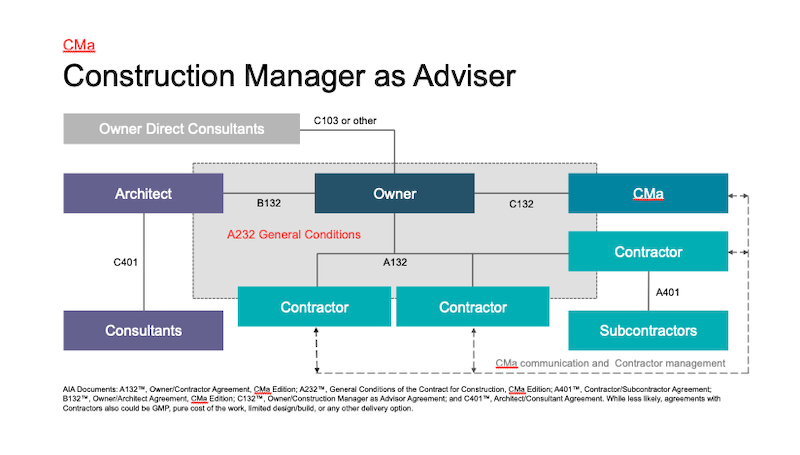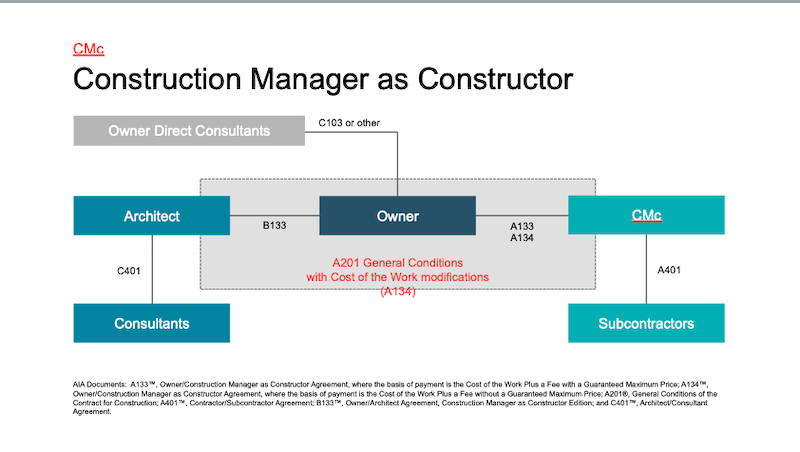On Nov. 15, the American Institute of Architects (AIA) plans to release its new and updated Construction Manager as Constructor (CMc) family of contract documents. Next February, the AIA will release its updated Construction Manager as Adviser (CMa) family of documents.
These documents get updated on a 10-year revision cycle.
The AIA divides its contract documents into nine families, organized by delivery method. These include families for design-bid-build (the most widely used contract model), design-build, and integrated project delivery, as well as contracts that specifically cover interiors, small projects, and digital practices. The design-bid-build document family was updated in 2017.
Under CMc, the Construction Manager comes on the project during the preconstruction phase to provide early collaboration. In the construction phase, the CM does the construction work, as if it were a General Contractor.
Under the CMa, the Construction Manager is also retained by the owner for early collaboration during the preconstruction phase. But the CMas don’t perform the construction work. The CMa documents are designed for complex projects with more than one prime contractor. During the construction phase, the CMa coordinates and manages the contractors, as well as providing cost estimating and other functions.
Susan Van Bell, Senior Director and Counsel – AIA Contract Documents Content, tells BD+C that the AIA solicited input from CM practitioners about revisions to the documents so that they’d better reflect current practices.
From those conversations, CMs suggested that one change they wanted was a way to tailor the document for the scope of preconstruction services without having the standard contract language be too restrictive.
Van Bell says the 2019 CMc revision addresses this issue by inserting “fill points” into the contract where more preconstruction details can be identified. The update also makes some edits to the standard preconstruction services scope.

A schematic of the family of documents for Construction Manager as Advisor.
The CMc documents now include insurance and bond exhibits, which had been added to the design-bid-build document family in its 2017 revision. Van Bell says there are also new exhibits for both the CMc and CMa documents that cover the role of the CM in sustainable projects.
The revised CMa documents clarify the CMa’s role in such areas as analyzing and coordinating the contractors’ schedules. The CMa is also the responsible party for managing a project’s digital information systems. “We clarified the communication process,” Van Bell says. The 2017 updates that required the establishment of protocols for digital data and BIM were carried into the CMc and CMa updates.
Related Stories
| Dec 3, 2013
Creating a healthcare capital project plan: The truth behind the numbers
When setting up a capital project plan, it's one thing to have the data, but quite another to have the knowledge of the process.
| Dec 3, 2013
Architects urge government to reform design-build contracting process
Current federal contracting laws are discouraging talented architects from competing for federal contracts, depriving government and, by inference, taxpayers of the best design expertise available, according to AIA testimony presented today on Capitol Hill.
| Dec 3, 2013
Construction spending hits four-year peak after rare spike in public outlays
An unusual surge in public construction in October pushed total construction spending to its highest level since May 2009 despite a dip in both private residential and nonresidential activity.
| Nov 27, 2013
BIG's 'oil and vinegar' design wins competition for the Museum of the Human Body [slideshow]
The winning submission by Bjarke Ingels Group (BIG) and A+ Architecture mixes urban pavement and parkland in a flowing, organic plan, like oil and vinegar, explains Bjarke Ingels.
| Nov 27, 2013
Retail renaissance: What's next?
The retail construction category, long in the doldrums, is roaring back to life. Send us your comments and projects as we prepare coverage for this exciting sector.
| Nov 27, 2013
Pediatric hospitals improve care with flexible, age-sensitive design
Pediatric hospitals face many of the same concerns as their adult counterparts. Inpatient bed demand is declining, outpatient visits are soaring, and there is a higher level of focus on prevention and reduced readmissions.
| Nov 27, 2013
Exclusive survey: Revenues increased at nearly half of AEC firms in 2013
Forty-six percent of the respondents to an exclusive BD+C survey of AEC professionals reported that revenues had increased this year compared to 2012, with another 24.2% saying cash flow had stayed the same.
| Nov 27, 2013
Wonder walls: 13 choices for the building envelope
BD+C editors present a roundup of the latest technologies and applications in exterior wall systems, from a tapered metal wall installation in Oklahoma to a textured precast concrete solution in North Carolina.
| Nov 27, 2013
University reconstruction projects: The 5 keys to success
This AIA CES Discovery course discusses the environmental, economic, and market pressures affecting facility planning for universities and colleges, and outlines current approaches to renovations for critical academic spaces.
| Nov 26, 2013
7 ways to make your firm more successful
Like all professional services businesses, AEC firms are challenged to effectively manage people. And even though people can be rather unpredictable, a firm’s success doesn’t have to be. Here are seven ways to make your firm more successful in the face of market variability and uncertainty.

















